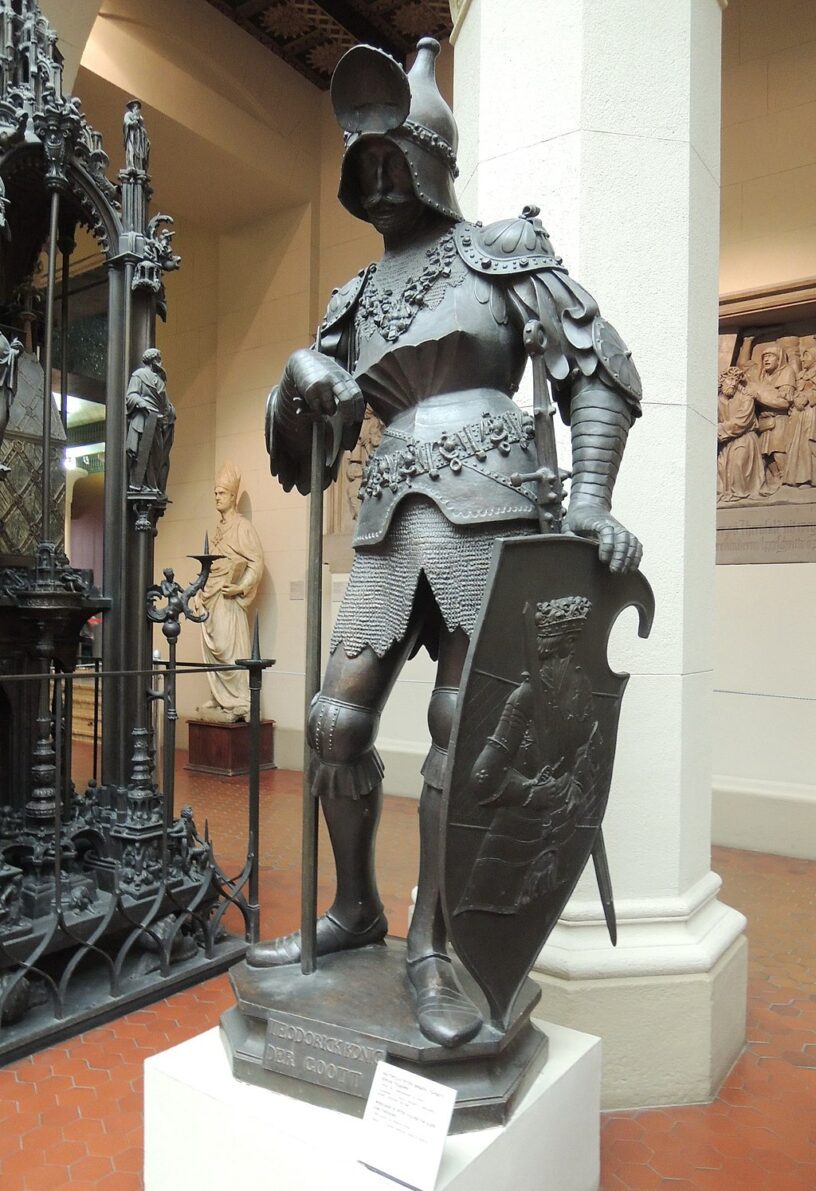
Theodoricus by British Museum from Wikimedia Commons
Top 10 Facts about the Rule of Theodoric
Theodoric the Great, also referred to as Flavius Theodoricus, was an Ostrogoth king who, under the encouragement and guidance of the Roman emperor Zeno, invaded Italy, overthrew King Odoacer, and ruled over a kingdom of Romans and Goths from 493-526 CE. Theodoric the Great is also known as Theodoric the Great. Although this identification has been contested by some academics, he was initially known by the name Dietrich (or Diederich). He entered German folklore under the name Dietrich von Bern, the protagonist of numerous stories in Middle High German literature.
1. He was sent to Constantinople as a hostage

Zeno by Tremissis from Wikimedia Commons
King Thiudimir of the Ostrogoths and one of his concubines gave birth to Theodoric around 454 CE. He was given the name Dietrich at his baptism, but when he was eight years old, he was sent as a prisoner to Constantinople, the capital of the Eastern Roman Empire, to ensure that his father would abide by a pact between the Romans and the Goths.
As a result, his name was romanized as “Theodoric.” Under the protection of the emperors Zeno and Leo I (reigned 457–474 CE), he spent ten years at court learning about Greco-Roman values (reigned 474-475 CE, 476-491 CE). Sidonius Apollinaris, a scribe, later referred to him as highly refined in his private and public life because he never learned to read or write but absorbed Roman cultural norms.
2. He was made Master of Soldiers under Zeno in 483 CE
Zeno appointed him Master of Soldiers in 483 CE, and a year later he was chosen to serve as Consul and given the name Flavius Theodoricus. These prizes were granted in appreciation for his assistance in preventing Strabo, sometimes known as “the Squinter,” from harassing the empire while he wasn’t fighting for its interests.
Theodoric the Amal and Theodoric Strabo, who were both regarded as kings of their respective Goth factions, competed with one another for the favour of the empire while, at other times, turning and ravaging the empire’s lands when they felt they were not being given enough respect or employment in arms.
3. He campaigned against the emperor that had brought him to power

Illus by an author from Wikimedia Commons
Theodoric was dispatched by Zeno to battle his rival General Illus, who had instigated a mutiny among the Isaurians in Asia Minor, after Recitach’s death and the unification of the Gothic forces under his command. Theodoric marched his troops back toward Constantinople after defeating Illus and putting an end to the uprising.
He was now the most powerful military leader in the area after defeating both his Gothic opponents and the Isaurians. He decided to take from Zeno what he believed he deserved but had not been offered: an allocation of land for his people and official recognition as their king. He launched a concerted offensive against the empire and the emperor who had propelled him to power.
4. He invaded Italy

Vuka river by anjči from Wikimedia Commons
At the Vuka River in 488 CE, he destroyed the countryside as he invaded Italy, where he first ran across Gepid resistance. Theodoric’s army swiftly routed and massacred them, regardless of whether they were allies of Odoacer or only defending their territory from invasion.
Theodoric defeated Odoacer after he continued marching and engaged his army at the Isonzo Bridge on August 28, 489 CE. When they fought again on September 29, 489 CE, Odoacer was once more vanquished. He fled to Verona, chasing after Theodoric. Theodoric kept advancing in his conquest of the land as he retreated to Ravenna and set up the city’s defences.
5. At some point Odoacer and Theodoric ruled jointly

Young Folks by Yonge, Charlotte Mary from Wikimedia Commons
The conflict lasted until February 25th, 493 CE, when John, the bishop of Ravenna, mediated a truce that established Odoacer and Theodoric as joint rulers. Theodoric rode into Ravenna on March 5th, 493 CE, and killed Odoacer by stabbing him to death on March 15th at a ceremonial banquet to celebrate the pact. Theodoric responded, “This is what you have done to my people,” in response to Odoacer’s last words, “Where is God?” in reference to his alleged mistreatment of the Goths in Italy and his annihilation of the Rugii tribe, who were linked to the Goths.
6. Theodoric worked to ensure fair representation of the diverse population
He issued decrees to provide equal representation before the law over a varied population of Goths and Romans. The majority of Romans followed Trinitarian Christianity, while the majority of Goths adhered to the Arian view of Christianity. The nation was thus divided along theological lines.
Theodoric, an Arian himself, enjoined religious tolerance and sought to unify the entire kingdom under his reign, regardless of his subjects’ nationality or religious affiliation. It is believed that he wanted to legalise his history in order to achieve this goal and to establish for himself and his people a lineage befitting of a ruler who would be revered by both the Goths and Romans.
7. Theodoric used marriages to form alliances

Anneau sigillaire by Kunsthistorisches Museum from Wikimedia Commons
Theodoric realised he needed more than this to secure his position on the throne, even though he was now officially recognised by the Roman Empire and had legal standing. In approximately 494 CE, he sent one of his daughters, Theodegotha, to marry King Alaric II of the Visigoths, and in approximately 496 CE, he sent another daughter, Ostrogotha, to marry King Sigismund of the Burgundians.
Shortly after defeating Odoacer in 493 CE, he wed Autofleda, the sister of King Clovis I of the Franks. By forming these partnerships, he sought to create a monarchy in which all of the former peoples known to the Romans as “barbarian tribes” might coexist happily.
8. He tried not to favour his own people above others
He actively sought to maintain peace among his citizens by holding court with men of many nationalities, much like Odoacer before him. In order to make it appear that everyone in his kingdom had access to the same rights under the law, in this case, criminal law, Theodoric reforms his prior rules in the Edictum Theodorici of 512 CE.
9. In an effort to maintain peace, he switched between his supposed allies frequently
Despite all of his achievements, he encountered difficulties and setbacks. The Franks declined to intervene when the Burgundians, who ought to have been allies, started assaults against Italy on the coast in 507 CE after Clovis I assassinated Theodoric’s ally Alaric II after defeating and killing him.
By 513 CE, Theodoric had dispatched his army against the Burgundians, conquered them, and expanded his realm. He constantly juggled his supposed allies in an effort to maintain peace while also appreciating the significance of appeasing Rome in the east.
10. He was unable to produce an heir
One of his other worries was that he was unable to leave behind a male heir, which he knew he would need in order for his dynasty to be acknowledged by the Roman authorities. He designated his grandson Athalaric as his successor after failing to produce this heir.
Amalasuntha, a daughter of Theodoric, and Eutharic, a prince of the Visigoths, had Athalaric as a son. The young prince Athalaric was the only option as Eutharic passed away during the marriage and Amalasuntha continued to be a widow. However, by designating him as his successor, Theodoric brought the Visigothic Kingdom under his dominion by making their son the rightful heir to his reign.
Even Alexander the Great, who often permitted conquered provinces to keep some degree of autonomy as long as they backed his cause, did not promote the same level of independent national pride that was allowed under Theodoric. Theodoric reigned over the Goths and the Romans for thirty years kept the peace, and worked for the welfare of his realm, bringing Italy from destruction to stability, then to prosperity and even luxury.
Even though his mausoleum in Ravenna was later desecrated when Belisarius defeated the Goths in 540 CE, it was later repaired and is still there today. He was buried there with full honours. For his efforts to rule over a heterogeneous populace without seeking to merge either culture into the other, Theodoric is hailed as “the Great” and is credited with revitalising Italy.
Planning a trip to Paris ? Get ready !
These are Amazon’s best-selling travel products that you may need for coming to Paris.
Bookstore
- The best travel book : Rick Steves – Paris 2023 – Learn more here
- Fodor’s Paris 2024 – Learn more here
Travel Gear
- Venture Pal Lightweight Backpack – Learn more here
- Samsonite Winfield 2 28″ Luggage – Learn more here
- Swig Savvy’s Stainless Steel Insulated Water Bottle – Learn more here
Check Amazon’s best-seller list for the most popular travel accessories. We sometimes read this list just to find out what new travel products people are buying.










